INSTITUT SUPERIEUR D'ANTHROPOLOGIE
INSTITUTE OF ANTHROPOLOGY
ONLINE COURSES / COURS A DISTANCE
FALL TERM : OCTOBER 2015
REGISTER NOW
AZERBADJAN – 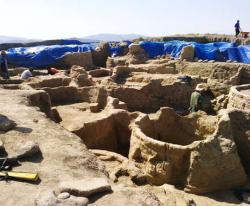 Mentesh - A joint Azerbaijani-French international archaeological expedition is completing a mission to study the Neolithic monuments in Azerbaijan’s Tovuz region. The joint expedition that explored the VI millennium BC settlement of Mentesh has lasted for eight years. Mentesh is one of the largest and most attractive ancient archaeological settlements of the South Caucasus. During excavations, a mound, measuring 160 square meters was discovered in the excavation site. Moreover, more than 30 human remains, ruins, objects made from bones, pottery, stone, and iron tools were also found in Mentesh. Earlier, Bertil Lionet, the head of the French archaeological team said that the excavations also provide an opportunity to study the flora and fauna of those times. For the future, Azerbaijani archeologists will co-operate with the University of Tokyo to continue studying the ancient settlements of the Neolithic period, including Goktepe and Hajiallamkhanli. The excavations in Goktepe were started by an Azerbaijani expedition in August 2008. The site is located in an area that is two hectares and eight meters high. The ancient settlement of Hajiallamkhanli is located about a kilometer to the west of Goktepe. The archeologists have discovered that the settlement dating back to the mid VII millennium BC. Hajiallamkhanli is now considered the oldest Neolithic settlement in Azerbaijan.
Mentesh - A joint Azerbaijani-French international archaeological expedition is completing a mission to study the Neolithic monuments in Azerbaijan’s Tovuz region. The joint expedition that explored the VI millennium BC settlement of Mentesh has lasted for eight years. Mentesh is one of the largest and most attractive ancient archaeological settlements of the South Caucasus. During excavations, a mound, measuring 160 square meters was discovered in the excavation site. Moreover, more than 30 human remains, ruins, objects made from bones, pottery, stone, and iron tools were also found in Mentesh. Earlier, Bertil Lionet, the head of the French archaeological team said that the excavations also provide an opportunity to study the flora and fauna of those times. For the future, Azerbaijani archeologists will co-operate with the University of Tokyo to continue studying the ancient settlements of the Neolithic period, including Goktepe and Hajiallamkhanli. The excavations in Goktepe were started by an Azerbaijani expedition in August 2008. The site is located in an area that is two hectares and eight meters high. The ancient settlement of Hajiallamkhanli is located about a kilometer to the west of Goktepe. The archeologists have discovered that the settlement dating back to the mid VII millennium BC. Hajiallamkhanli is now considered the oldest Neolithic settlement in Azerbaijan.
http://www.azernews.az/azerbaijan/85110.html
PALESTINE – VIDEO - Gaza - Gaza left much of the strip in ruins. The territory’s historical monuments were left severely damaged by this and previous attacks. This audio slideshow explores how Gaza’s archaeologists work to preserve the area’s antiquities despite a lack of funding and international assistance. Ghassan Weshah, head of the department of archaeology at the Islamic University of Gaza, says the UN Educational, Scientific and Cultural Organization has warned that various Palestinian archaeological sites, including the monastery of St Hilarion, are endangered.
http://www.scidev.net/global/conflict/multimedia/preserve-gaza--archaeological-heritage.html
ARABIE SAOUDITE – 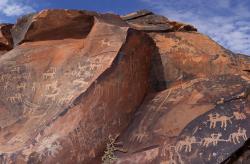 Hail rock - Happy with the inclusion of Hail rock art in the United Nations Educational, Scientific and Cultural Organization (UNESCO) World Heritage List, which is the second entry in consecutive years as the Historic Jeddah was listed last year, a wider-section of Saudi society hailed the decision as “unique achievement” for Kingdom in two successive years.
Hail rock - Happy with the inclusion of Hail rock art in the United Nations Educational, Scientific and Cultural Organization (UNESCO) World Heritage List, which is the second entry in consecutive years as the Historic Jeddah was listed last year, a wider-section of Saudi society hailed the decision as “unique achievement” for Kingdom in two successive years.
http://www.albawaba.com/editorchoice/all-hail-hail-rock-art-saudis-praise-sites-inclusion-unesco-heritage-list-718132
TURQUIE – 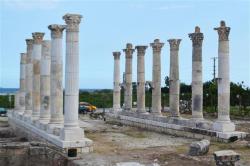 Soli Pompeipolis - This year’s excavations will start next week in the ancient city of Soli Pompeipolis, located in the southern province of Mersin’s Mezitli district. The work will focus on uncovering the rest of a Roman-era street lined with columns. During last year’s 37-day excavations, the ancient city was found to be a very active harbor in the 1st B.C. and 1st A.D., said Yağcı, adding the work in 2013 unearthed the columned street and Roman stores in an architectural order. Yağcı said they also wanted to find early Roman-era artifacts and continue work at Soli Mound with a team. “Last year, we started a project there related to the 6th and 7th century colonization periods. We want to maintain this project and reveal history,” he said. Mezitli Mayor Neşet Tarhan said the district was home to rich archaeological findings, as Soli Pompeiopolis was an important ancient harbor city. “All of the Pompeiopolis columns have not been unearthed yet. This place was damaged during a large earthquake but almost 40 percent of the columns still survive,” he said, adding that the city would continue to support archaeological works.
Soli Pompeipolis - This year’s excavations will start next week in the ancient city of Soli Pompeipolis, located in the southern province of Mersin’s Mezitli district. The work will focus on uncovering the rest of a Roman-era street lined with columns. During last year’s 37-day excavations, the ancient city was found to be a very active harbor in the 1st B.C. and 1st A.D., said Yağcı, adding the work in 2013 unearthed the columned street and Roman stores in an architectural order. Yağcı said they also wanted to find early Roman-era artifacts and continue work at Soli Mound with a team. “Last year, we started a project there related to the 6th and 7th century colonization periods. We want to maintain this project and reveal history,” he said. Mezitli Mayor Neşet Tarhan said the district was home to rich archaeological findings, as Soli Pompeiopolis was an important ancient harbor city. “All of the Pompeiopolis columns have not been unearthed yet. This place was damaged during a large earthquake but almost 40 percent of the columns still survive,” he said, adding that the city would continue to support archaeological works.
http://www.hurriyetdailynews.com/roman-streets-of-ancient-soli-gradually-unearthed-.aspx?PageID=238&NID=85266&NewsCatID=375
ROYAUME UNI – 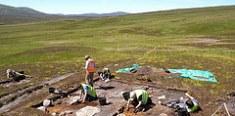 Cairngorm glens - Archaeologists working on the National Trust for Scotland’s Mar Lodge Estate in Aberdeenshire have uncovered evidence that people were active in this mountainous landscape thousands of years earlier than previously thought. Excavations at sites deep in the Cairngorm glens have produced radiocarbon dates which demonstrate a human presence as far back as 8,100 BC, with some places being revisited over many thousands of years. The first evidence that hunter-gatherer groups were living in the Cairngorms was discovered on the Mar Lodge Estate in 2003, when a major footpath repair programme turned up prehistoric worked stone artefacts. Without radiocarbon dates only an approximate date for the artefacts was possible at the time, with initial estimates of around 5,000 BC. Now entering its third season, the project is casting fascinating light on how early people used these upland landscapes after the retreat of the last glaciers – something about which very little is known in Scotland. Radiocarbon dates of 6,200 - 6,100 BC from a site in Glen Geldie are remarkable because they coincide with the most dramatic climatic deterioration seen since the last ice age, in which permanent snow fields would have been a feature of the Cairngorms, and glaciers may have started reforming. The site is being excavated by a team from University College Dublin. The earliest dates come from a site in Glen Dee, at a key stopping point for travellers moving through mountain passes between Deeside and Speyside, with links both to north west Scotland and the North Sea coast. Excavations by Aberdeen University are revealing a complex history of settlement, with people gathering by the riverside as early as c8,100 BC – perhaps only a few hundred years after communities begin to move back into Scotland as the ice retreated. The sandy beach at this ideal salmon-fishing ground continued to attract people for thousands of years, until at least c900 BC – the late bronze age.
Cairngorm glens - Archaeologists working on the National Trust for Scotland’s Mar Lodge Estate in Aberdeenshire have uncovered evidence that people were active in this mountainous landscape thousands of years earlier than previously thought. Excavations at sites deep in the Cairngorm glens have produced radiocarbon dates which demonstrate a human presence as far back as 8,100 BC, with some places being revisited over many thousands of years. The first evidence that hunter-gatherer groups were living in the Cairngorms was discovered on the Mar Lodge Estate in 2003, when a major footpath repair programme turned up prehistoric worked stone artefacts. Without radiocarbon dates only an approximate date for the artefacts was possible at the time, with initial estimates of around 5,000 BC. Now entering its third season, the project is casting fascinating light on how early people used these upland landscapes after the retreat of the last glaciers – something about which very little is known in Scotland. Radiocarbon dates of 6,200 - 6,100 BC from a site in Glen Geldie are remarkable because they coincide with the most dramatic climatic deterioration seen since the last ice age, in which permanent snow fields would have been a feature of the Cairngorms, and glaciers may have started reforming. The site is being excavated by a team from University College Dublin. The earliest dates come from a site in Glen Dee, at a key stopping point for travellers moving through mountain passes between Deeside and Speyside, with links both to north west Scotland and the North Sea coast. Excavations by Aberdeen University are revealing a complex history of settlement, with people gathering by the riverside as early as c8,100 BC – perhaps only a few hundred years after communities begin to move back into Scotland as the ice retreated. The sandy beach at this ideal salmon-fishing ground continued to attract people for thousands of years, until at least c900 BC – the late bronze age.
http://www.nts.org.uk/News/#
TURQUIE –  Istanbul - Turkey’s Cultural and Natural Heritage Preservation Board has refused to declare a plot of land in Istanbul’s Silivri district as a first-degree archaeological site despite the discovery of artifacts from the Hellenistic, Roman and Byzantine eras. Now, the artifacts face an even greater threat as a wind-power company has indicated that it wants to cover the findings and continue constructing 21 wind turbines. Among the artifacts were many Hellenistic- and Roman-era tombs and one-meter walls. The Istanbul Archaeology Museum was informed about the artifacts, and further excavations by museum officials unearthed valuable architectural remains dating back to the late Byzantine era in the 11th and 12th century A.D. The presence of many Byzantine-era tombs in the immediate vicinity suggests there could be a monastery in the area, according to officials. “This is a very important development for Thrace and Istanbul archaeology. It should be declared a first-degree archaeological site immediately,” one of the officials said. “Since brick pieces were not found in the remains of the wall and a roughhewn stone was seen, it might be a Roman-era settlement,” the Istanbul Archaeology Museum said in a statement. “The remains of a structure, which is made up of big block stones, is thought to have been a wall from the Hellenistic era. The area might have been a Hellenistic and Roman settlement because the ceramic pieces around this structure show Hellenistic and Roman-era characteristics. The area might have served as a graveyard in the Byzantine era.”
Istanbul - Turkey’s Cultural and Natural Heritage Preservation Board has refused to declare a plot of land in Istanbul’s Silivri district as a first-degree archaeological site despite the discovery of artifacts from the Hellenistic, Roman and Byzantine eras. Now, the artifacts face an even greater threat as a wind-power company has indicated that it wants to cover the findings and continue constructing 21 wind turbines. Among the artifacts were many Hellenistic- and Roman-era tombs and one-meter walls. The Istanbul Archaeology Museum was informed about the artifacts, and further excavations by museum officials unearthed valuable architectural remains dating back to the late Byzantine era in the 11th and 12th century A.D. The presence of many Byzantine-era tombs in the immediate vicinity suggests there could be a monastery in the area, according to officials. “This is a very important development for Thrace and Istanbul archaeology. It should be declared a first-degree archaeological site immediately,” one of the officials said. “Since brick pieces were not found in the remains of the wall and a roughhewn stone was seen, it might be a Roman-era settlement,” the Istanbul Archaeology Museum said in a statement. “The remains of a structure, which is made up of big block stones, is thought to have been a wall from the Hellenistic era. The area might have been a Hellenistic and Roman settlement because the ceramic pieces around this structure show Hellenistic and Roman-era characteristics. The area might have served as a graveyard in the Byzantine era.”
http://www.hurriyetdailynews.com/wind-power-plant-to-be-built-on-archaeological-site-in-istanbuls-silivri.aspx?pageID=238&nID=85211&NewsCatID=375
DANEMARK – 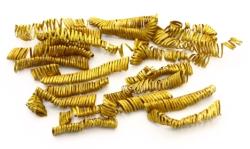 Boeslunde - The Danish National Museum announced on Wednesday that archaeologists have uncovered a trove of gold spirals that may have been used for religious ceremonies during the Bronze Age, when the Danes’ ancestors worshiped the sun. The spirals were recovered from a site that had been excavated before, where a team found four gold bracelets. The some 2,000 gold spirals that were found have been dated as originating between 900-700 B.C. Each spiral is made up of pure gold thread and measures up to three centimeters in length. The entire find weighs between 200-300 grammes. Archaeologists are still unsure what the spirals may have been used for, as this is the first time such a find has been made in Denmark. “Maybe the spirals were fastened to threads lining a hat or parasol. Maybe they were woven into hair or embroidered on a ceremonial garb. The fact is that we do not know, but I am inclined to believe that they were part of a priest-king’s garb or part of some headwear,” Flemming Kaul from the Danish National Museum said in a press release. The excavation area – located in the Boeslunde district in southwestern Zealand – has been a veritable treasure trove of archaeological finds. This latest discovery makes it the area where the most gold jewellery and artefacts – in terms of sheer weight – have been recovered from the north European Bronze Age. Flemming Kaul from the National Museum also believes that the area had some sort of religious significance as a place where Bronze Age worshippers carried out rituals and sacrifices to the higher powers. “Maybe the priest king had a golden bracelet around his wrist, and the gold spirals adorned his cape or his hat, where during rituals they shone like the sun. The sun was one of the holy symbols in the Bronze Age and gold was presumably seen as having some sort of particular magic power. It is colored like the sun, it shines like the sun, and because gold lasts forever, it was also seen as containing some of the Sun’s power,” Kaul said. Archaeologists from both the National Museum and West Zealand Museum are convinced that there is still more golden treasure to be found at Boeslunde.
Boeslunde - The Danish National Museum announced on Wednesday that archaeologists have uncovered a trove of gold spirals that may have been used for religious ceremonies during the Bronze Age, when the Danes’ ancestors worshiped the sun. The spirals were recovered from a site that had been excavated before, where a team found four gold bracelets. The some 2,000 gold spirals that were found have been dated as originating between 900-700 B.C. Each spiral is made up of pure gold thread and measures up to three centimeters in length. The entire find weighs between 200-300 grammes. Archaeologists are still unsure what the spirals may have been used for, as this is the first time such a find has been made in Denmark. “Maybe the spirals were fastened to threads lining a hat or parasol. Maybe they were woven into hair or embroidered on a ceremonial garb. The fact is that we do not know, but I am inclined to believe that they were part of a priest-king’s garb or part of some headwear,” Flemming Kaul from the Danish National Museum said in a press release. The excavation area – located in the Boeslunde district in southwestern Zealand – has been a veritable treasure trove of archaeological finds. This latest discovery makes it the area where the most gold jewellery and artefacts – in terms of sheer weight – have been recovered from the north European Bronze Age. Flemming Kaul from the National Museum also believes that the area had some sort of religious significance as a place where Bronze Age worshippers carried out rituals and sacrifices to the higher powers. “Maybe the priest king had a golden bracelet around his wrist, and the gold spirals adorned his cape or his hat, where during rituals they shone like the sun. The sun was one of the holy symbols in the Bronze Age and gold was presumably seen as having some sort of particular magic power. It is colored like the sun, it shines like the sun, and because gold lasts forever, it was also seen as containing some of the Sun’s power,” Kaul said. Archaeologists from both the National Museum and West Zealand Museum are convinced that there is still more golden treasure to be found at Boeslunde.
http://www.thelocal.dk/20150708/danish-archaeologists-make-huge-bronze-age-find
PEROU –  Nazca - Anthropologists have discovered 24 examples of the mysterious Nazca Lines in the arid region near Nazca of southern Peru, a Yamagata University institute researching the geoglyphs announced July 7. The team began investigating the northern slopes of the urban areas of Nazca, Peru, from autumn 2013 and discovered 17 geoglyphs depicting llamas before the end of fiscal 2013. The 24 newly discovered geoglyphs are believed to date to around 400 B.C.-200 B.C., making them older than the iconic Nazca Line drawing known as the hummingbird. They range from 5 to 20 meters in length. Most of the lines are heavily eroded, making them difficult to make out with the naked eye, but the researchers used equipment including a 3-D scanner to sketch out the pattern. Most of the drawings seem to depict llamas, the team said.
Nazca - Anthropologists have discovered 24 examples of the mysterious Nazca Lines in the arid region near Nazca of southern Peru, a Yamagata University institute researching the geoglyphs announced July 7. The team began investigating the northern slopes of the urban areas of Nazca, Peru, from autumn 2013 and discovered 17 geoglyphs depicting llamas before the end of fiscal 2013. The 24 newly discovered geoglyphs are believed to date to around 400 B.C.-200 B.C., making them older than the iconic Nazca Line drawing known as the hummingbird. They range from 5 to 20 meters in length. Most of the lines are heavily eroded, making them difficult to make out with the naked eye, but the researchers used equipment including a 3-D scanner to sketch out the pattern. Most of the drawings seem to depict llamas, the team said.
http://ajw.asahi.com/article/behind_news/social_affairs/AJ201507080063
SYRIE – 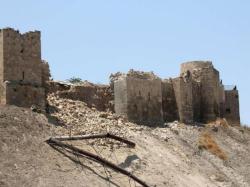 Alep - C'est un vestige de plus qui s'est effondré en Syrie ce week-end. Une partie de la muraille de la citadelle d'Alep s'est écroulée après l'explosion d'un tunnel situé dans la vieille ville syrienne, classée au patrimoine mondial de l'humanité. À l'origine de cette déflagration, «des groupes terroristes» qui ont agi dans la nuit de samedi à dimanche, selon l'agence officielle Sana. «Une partie de la muraille principale de la citadelle s'est effondrée», a confirmé à l'AFP le directeur de l'Observatoire syrien des droits de l'Homme (OSDH), Rami Abdel Rahmane. Selon l'ONG qui dispose d'un large réseau de sources à travers le pays, le tunnel aurait été creusé par les rebelles mais c'est le régime qui l'aurait fait exploser dans la nuit afin d'empêcher les insurgés de parvenir à une position de l'armée.
Alep - C'est un vestige de plus qui s'est effondré en Syrie ce week-end. Une partie de la muraille de la citadelle d'Alep s'est écroulée après l'explosion d'un tunnel situé dans la vieille ville syrienne, classée au patrimoine mondial de l'humanité. À l'origine de cette déflagration, «des groupes terroristes» qui ont agi dans la nuit de samedi à dimanche, selon l'agence officielle Sana. «Une partie de la muraille principale de la citadelle s'est effondrée», a confirmé à l'AFP le directeur de l'Observatoire syrien des droits de l'Homme (OSDH), Rami Abdel Rahmane. Selon l'ONG qui dispose d'un large réseau de sources à travers le pays, le tunnel aurait été creusé par les rebelles mais c'est le régime qui l'aurait fait exploser dans la nuit afin d'empêcher les insurgés de parvenir à une position de l'armée.
https://fr.news.yahoo.com/syrie-citadelle-dalep-partie-d%C3%A9vast%C3%A9e-explosion-150204240.html